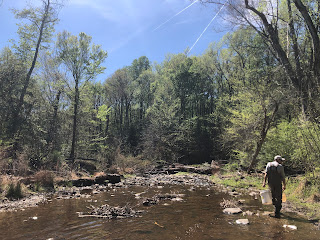Cornelius Creek: A Tentative Study Area
UPDATE: I have settled on the city of Richmond, Virginia for my study site.
The area I have chosen to study is still tentative. While
Cornelius Creek presents a unique research opportunity as I have yet to find
anything about it online, the same “blank page” quality that intrigues me might
make it too difficult. Since I’m no stranger to fieldwork, I would gladly
accept the challenge of spending hours in the woods identifying the different
species and ecosystems. However, seeing as I work full time, just bought a
house, and adopted two 2-month-old kittens… I’m not sure how feasible it will
be for me to focus on one small section of the James River Watershed. That
being said, my backup plan is to expand my study focus to encompass all of
Richmond City limits. At least this way I will still be able to research my
favorite city in the US with the bonus that whatever information I gather on
Cornelius Creek will still be applicable, just in a broader sense.
Here is the original submission for my study area (look out
for updates!):
The area I have chosen for my biodiversity study is
Cornelius Creek located in Henrico County, VA. The creek is a tributary of the
James River and winds through residential areas and along major roads for
several miles before joining the James near Osborne Landing. I plan on focusing
on the section of the stream and surrounding forest beginning after Hadad’s
Lake (a public outdoor waterpark of sorts fed by the creek) up to its terminus.
A few months ago I visited Cornelius Creek while on a
backpack electrofishing sampling run for work (VA DWR) and I was immediately
stricken by the seemingly untouched wilderness of the area even though it is
situated next a busy highway, a waterpark, and residences. The slow march of
progress will inevitably continue to lead to habitat loss or alteration, yet
being able to maintain strips of untouched land can be beneficial to the
biodiversity of the surrounding areas by creating havens for local species as
well as developing wildlife corridors. I believe the property is currently
owned by the Henrico Police Department and is off-limits to the public, but as
a DWR employee I have access to it which would allow me to do a deeper
investigation of the various species and ecosystems within. It is doubtful that
I would be able to find any threatened or endangered species within the
boundaries of my study area, but I think creating a product that shows the
public the beauty of pockets of wilderness like Cornelius Creek that exist in
their own backyards could do much to help protect and conserve them. Maybe it
could also lead to creating a public access trail that would help protect the
area for years to come in the same way as conservation easements do.
Another reason for my choice is that there was a massive
illegal waste dump that happened there a few weeks back and I don’t think it
received any media coverage since it’s not open for public recreation. I’m sure
events like that happen a lot more frequently than anyone besides the local
authorities are aware of. So, putting a “face” to the victim might open the
conversation for increased monitoring and stricter penalties (either legally or
in the court of public opinion) which could help prevent future accidents not
only in my study area but others like it.





Comments
Post a Comment